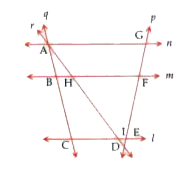Given the linear equation 2x+3y−8=0 , write another linear equation in two variables such that the geometrical representation of the pair so formed is (i) intersecting lines (ii) Parallel lines (iii) coincident lines
To solve the problem, we need to write another linear equation in two variables based on the given equation 2x+3y−8=0 such that the geometrical representation of the pair of lines formed is:
(i) Intersecting Lines
1. Identify the given equation:
The given equation is 2x+3y−8=0. We can express this in the standard form A1x+B1y+C1=0 where A1=2, B1=3, and C1=−8.
2. Condition for intersecting lines:
For two lines to intersect, the condition is:
A1A2≠B1B2
This means the ratios of the coefficients of x and y must not be equal.
3. Choose a different equation:
Let's take 3x+2y−5=0 as our second equation. Here, A2=3, B2=2, and C2=−5.
4. Check the condition:
23≠32
Since the ratios are not equal, the lines represented by these equations will intersect.
(ii) Parallel Lines
1. Condition for parallel lines:
For two lines to be parallel, the condition is:
A1A2=B1B2≠C1C2
2. Choose a parallel equation:
We can use 2x+3y−7=0 as our second equation. Here, A2=2, B2=3, and C2=−7.
3. Check the condition:
22=33and−8−7≠1
This satisfies the condition for parallel lines.
(iii) Coincident Lines
1. Condition for coincident lines:
For two lines to be coincident, the condition is:
A1A2=B1B2=C1C2
2. Choose a coincident equation:
We can multiply the original equation by 2 to get 4x+6y−16=0. Here, A2=4, B2=6, and C2=−16.
3. Check the condition:
24=36=−8−16=12
This satisfies the condition for coincident lines.
Summary of the Equations:
- Intersecting Lines: 3x+2y−5=0
- Parallel Lines: 2x+3y−7=0
- Coincident Lines: 4x+6y−16=0
---
The given equation is 2x+3y−8=0. We can express this in the standard form A1x+B1y+C1=0 where A1=2, B1=3, and C1=−8.
For two lines to intersect, the condition is:
A1A2≠B1B2
This means the ratios of the coefficients of x and y must not be equal.
Let's take 3x+2y−5=0 as our second equation. Here, A2=3, B2=2, and C2=−5.
23≠32
Since the ratios are not equal, the lines represented by these equations will intersect.
For two lines to be parallel, the condition is:
A1A2=B1B2≠C1C2
We can use 2x+3y−7=0 as our second equation. Here, A2=2, B2=3, and C2=−7.
22=33and−8−7≠1
This satisfies the condition for parallel lines.
For two lines to be coincident, the condition is:
A1A2=B1B2=C1C2
We can multiply the original equation by 2 to get 4x+6y−16=0. Here, A2=4, B2=6, and C2=−16.
24=36=−8−16=12
This satisfies the condition for coincident lines.
- Intersecting Lines: 3x+2y−5=0
- Parallel Lines: 2x+3y−7=0
- Coincident Lines: 4x+6y−16=0
Topper's Solved these Questions
Similar Questions
The graph of every linear equation in two variables need not be a line.
View SolutionIf a pair of linear equations in two variables is consistent, then the lines represented by two equations are
View SolutionAny solution of the linear equation 2x+0y+9=0 in the two variables is of the form
View SolutionIf a pair of linear equations in two variables is consistent, then the lines represented by two equations are (a) intersecting (b) parallel (c) always coincident (d) intersecting or coincident
View SolutionGive the geometric representations of y=3 as an equation
(i) in one variable
(ii) in two variables
View SolutionGive the geometric representations of 2x+9=0 as an equation
(i) in one variable
(ii) in two variables
View SolutionGiven the geometrical representation of 2x+13=0 as an equation in One variable (ii) two variables
View SolutionDraw the graph of each of the following linear equations in two variables: −x+y=6 (ii) y=2x
View SolutionIn the adjoining figure write.
(i) all pairs of parallel lines
(ii) all pairs of intersecting lines.
(iii) Concurrent lines.
(iv) Collinear points.

View SolutionIf a pair of linear equations is consistent, then the lines represented by them are
View Solution
